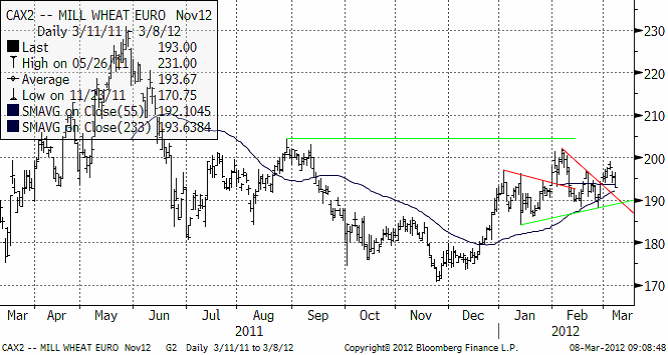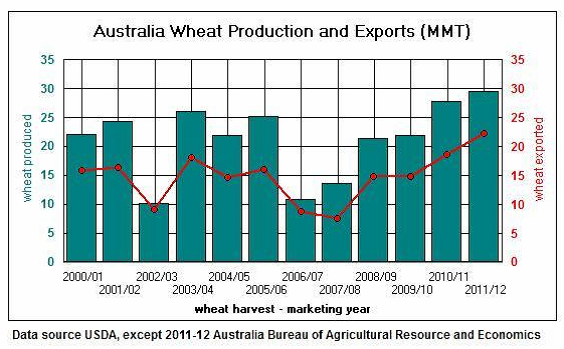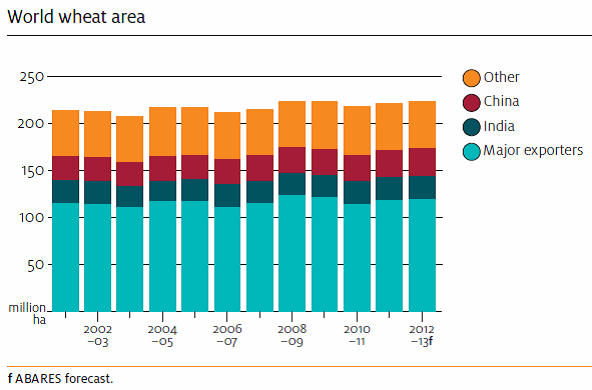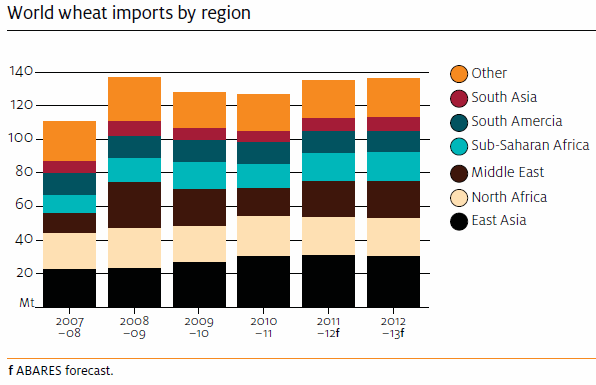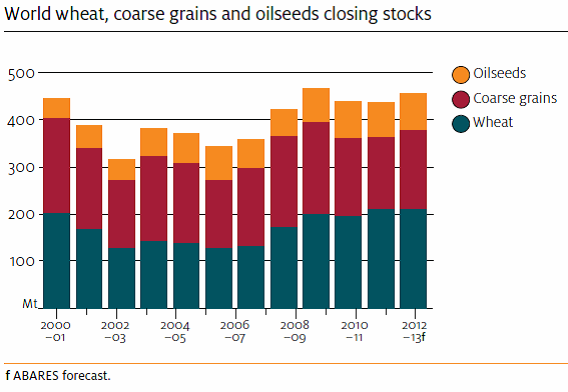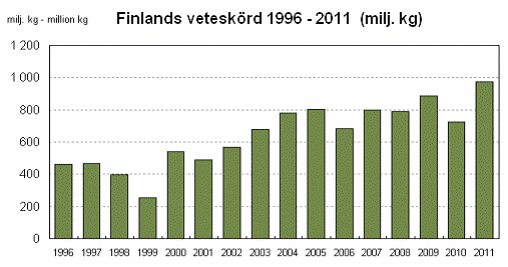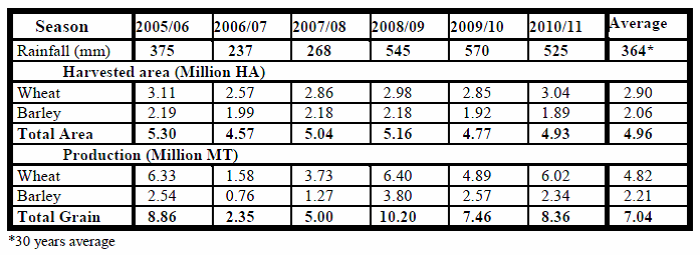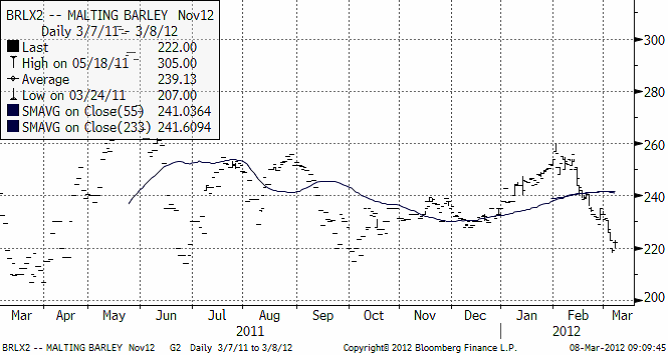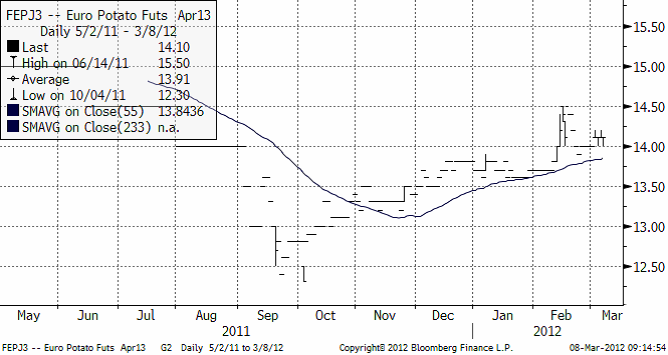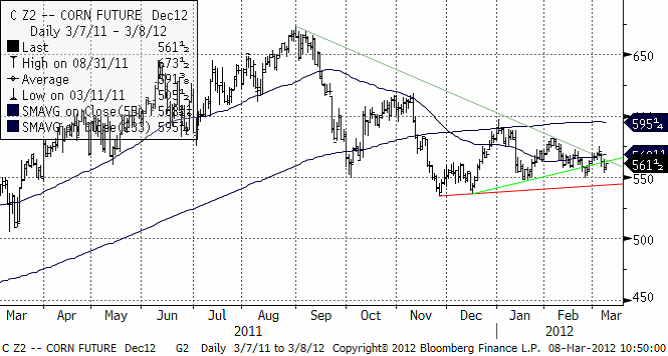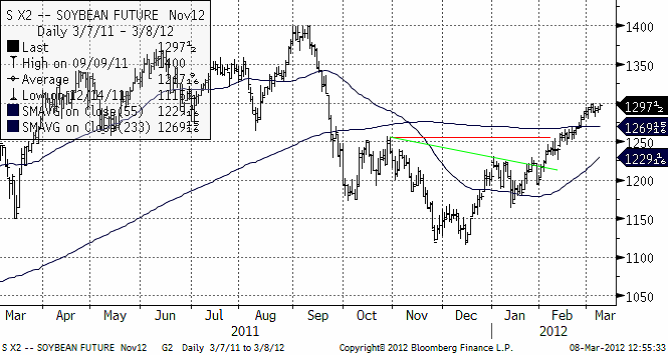Analys
SEB – Jordbruksprodukter, vecka 10 2012
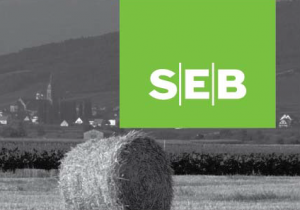 Inledning
Inledning
Den senaste veckan har varit lugn med överlag oförändrade eller något lägre priser på jordbruksprodukter. I morgon fredag klockan 14:30 släpps WASDE för mars och det brukar innebära lite större prisrörelser. Vi tror att rörelserna då generellt sett blir nedåtriktade. ABARES har släppt en stor rapport, som vi lagt i centrum för det här veckobrevet, som annars är lite kortare i samklang med den mycket lugna marknaden den senaste veckan.
Vete
Novemberterminen på Matif har backat nedåt efter att marknaden misslyckats med att nå över 200 euro per ton.
ABARES förutspår att veteskörden i Australien för 2011/12 kommer att uppgå till rekordhöga 29.5 mt, vilket skulle vara nytt rekord för andra året i rad då förra årets skörd uppgick till 27.9 mt.
I sin prognos för 2012/13 skriver ABARES att trots en förväntad ökning av arealen för vete i världen uppskattas den globala veteproduktionen minska med 2 procent till ca 682 mt för 2012/13, vilket är i linje med IGC’s estimat förra månaden på 680 mt.
I USA förväntas vete produktionen att öka med 6 procent till omkring 58 mt, som ett resultat av högre areal och en återgång till en genomsnittlig avkastning efter dåliga säsongsmässiga förhållanden under 2011/12. Veteproduktionen i Canada förväntas också öka med 2 procent till ca 26 mt.
Inom den europeiska unionen beräknas veteproduktionen för 2012/13 att stiga med 2 procent till ca 140 mt. Torrt väder i vissa regioner har lett till minskad sådd areal av raps, till förmån för höstvete som sås senare.
I Kina förväntas den totala produktionen av höst- och vårvete uppgå till ca 120 mt, en ökning med 2 procent, medan produktionen i Indien, som är världens tredje största producent av vete efter EU och Kina, förväntas minska med 4 procent till ca 83 mt.
I Argentina förväntas produktionen bli i stort sett oförändrad runt 13 mt.
Produktionen av vete i Ryssland förväntas öka med 5 procent till ca 59 mt för 2012/13 till följd av tillräcklig nederbörd under sådden samt ett fullgott snötäcke under vintern. Produktionen i Ukraina väntas däremot minska till följd av höstens torka som drabbade de västra delarna av landet. I Kazakstan förväntas produktionen att falla med 31 procent till ca 16 mt. Väderförhållandena föregående säsong var exceptionellt gynnsamma för veteproduktionen där lantbrukare fick rekordavkastningar som låg nästan 60 procent över föregående 10-års genomsnitt.
Australiens egen vete produktion förväntas falla med 13 procent till ca 26 mt 2012/13 eftersom arealen för vete tros minska med 3 procent till 13.7 m hektar då man estimerar att vetepriset, i jämförelse med andra större grödor, blir mindre attraktivt. Exporten av australiensiskt vete förväntas bli i stort sett oförändrar runt 21 mt.
Den globala konsumtionen av vete beräknas öka marginellt till 681 mt under 2012/13 och beror till stor del på en ökad konsumtion av vete som human föda i takt med en ökad befolkningstillväxt i världen.
Konsumtionen av fodervete förväntas kvarstå på en hög nivå i förhållande till de senaste åren, men beräknas falla från den rekordhöga nivån under 2011/12 då användningen ökade som ett resultat av höga priser på majs i förhållande till fodervete. Östasien står för en stor del av den ökade konsumtion av fodervete, där efterfrågan delvis har tillgodosetts genom import av australiensiskt fodervete från 2010/11 års regndrabbade skörd.
Handel med vete under 2012/13 beräknas stiga marginellt till ca 136 mt, till stor del beroende på höga lager och ytterligare en säsong av en relativt hög estimerad produktion i de stora exportländerna. Exporten förväntas bli oförändrad för de flesta stora exportländerna utom i USA där exporten bedöms öka med 4 procent till ca 25 mt som en följ av en förväntad högre produktion. Den globala importen av vete förväntas stiga marginellt i linje med exporten.
Globala utgående lager för vete 2012/13 förväntas öka med 1 procent till ca 210 mt till följd av att produktionen överträffar konsumtionen. Lagren i de flesta stora exportländerna förväntas bli i stort sett oförändrade med undantag av USA där de förväntas öka med 10 procent till ca 28 mt med tanke på den förväntade ökningen i produktionen.
Från HGCA i Storbritannien rapporteras det att vädret under vintern 2011/12 har varit varmare än genomsnittet för en stor del av perioden, med undantag av en kort men mycket kall period i början av februari. Nederbörden under samma tid har haft stora regionala skillnader där Skottland, Wales och norra England fick en mycket blöt höst och vinter medan stora delar av södra, centrala och östra England sedan i september endast har fått 70-80% av den, för den här tiden, normala nederbörden.
Grödorna har utvecklats väl under vintern, även om det blöta vädret i Skottland har inneburit förseningar i tillväxtfasen. Det milda vädret kan dock komma att orsaka sjukdomar, särskilt mjöldagg och rost hos spannmål och det finns en stor risk för ljus bladfläcksjuka hos raps. För vårt östra grannland Finland uppgick den totala spannmålsskörden för 2011 till ca 3,7 mt enligt Tike. För samtliga spannmålsslag ökade odlingsarealerna och hektarskördarna från 2010 med vete i spetsen där odlingsarealen ökade med en femtedel jämfört med året innan och skörden uppgick till ca 975 000 ton, vilket var den hittills största i Finland. Produktionen av höstvete steg nästan till det dubbla (173 000 ton) och produktionen av vårvete ökade med 26 procent till 801 000 ton. För både vår- och höstvete var mängderna av kvarnduglig skörd de största på flera årtionden.
Tittar vi på de baltiska länderna så säger preliminära uppgifter att spannmålsproduktionen i Estland uppgick till 771 900 ton under 2011, vilket är 14% mer än föregående år. Av den totala produktionen var 360 400 ton vete, 294 400 ton korn och 30 900 ton råg. Sådd areal för vete uppgick till 128 500 hektar, vilket är den största de senaste trettio åren.
Produktionen av raps och rybs uppgick till 142 600 ton, vilket är 10% mer än 2010 och också den största skörden under de senaste två decennierna.
I Lettland uppgick spannmålsskörden till 1.4 mt under förra året, vilket är något lägre än skörden 2010, till följd av minskad avkastning och minskad produktion av höstgrödor. Året var däremot gynnsamt för vårgrödorna där bl.a produktionen av vårvete ökade rejält.
Litauen fick däremot en högre spannmålsskörd under 2011 och den uppgick till 3.3 mt jämfört med 2.9 mt under 2010. Den totala produktionen av vete ökade till 3.2 mt från 2.8 mt året innan. Landets rapsproduktion uppgick till 484 300 ton jämfört med 416 700 ton under 2010.
Marockos grödor, som fick en sen start pga av det försenade regnet – i vissa områden avslutades sådden så sent som i slutet av december, befinner sig nu i en kritisk fas som kommer att avgöra 2011/12 års skörd. Förutom bristen på nederbörd och den sena sådden av vete och korn, har ovanligt låga temperaturer påverkat groning och hämmat grödornas utveckling. Den stora oron över bristen på regn och dess påverkan på jordbruket fick den marockanska kungen, the Commander of the Faithful, att uppmana sitt folk att be om regn och regn böner ägde rum den 6 januari i flera regioner i landet.
Det efterlängtade regnet kom också tio dagar senare, men med mindre intensitet än vad man hade hoppats på. Nederbörden från 1 september till 17 januari var ca 27 procent lägre än genomsnittet och 43 procent lägre jämfört med föregående år. Marockos import av vete per mitten av januari uppskattades till 1.18 mt, en nedjustering med 10 procent jämfört med samma period förra året, där Frankrike är den största leverantören med 77 procent, medan Ryssland och Ukraina står för 9 respektive 7 procent. Uttalandet om att Marocko kan komma att importera 1-1.1 mt vete under perioden mars-maj i år efter att regeringen beslutat att häva importtullar för vete under två månaders tid gav därför stöd till kvarnvetet på Matif. Tabellen nedan visar skördad areal och produktion av vete och korn i Marocko under de senaste 6 åren:
Även i Portugal ber nu lantbrukare om ett mirakel efter att landet har genomlidit den torraste februari månad på 80 år där torkan förstör betesmarker och leder till skogsbränder, vilket förvärrar landets ekonomiska kris. Det nyckfulla vädret förväntas dessutom hålla sig till slutet på mars, vilket skulle förvärra en torka som redan nu klassificeras som svår och extrem och det torra kallt väder på natten och värme under dagen förstör grödorna.
Maltkorn
Novemberkontraktet på maltkorn har fortsatt att falla med förnyad styrka ner mot nivåer kring 200 till 220 där marknaden tidigare har funnit stöd. Vi förväntar oss att prisfallet även denna gång hejdar sig åtminstone temporärt på den här nivån. Om man är ute för att prissäkra kan man därför gott avvakta något för att kanske kunna sälja på exempelvis 230 euro igen inom kort. Detta är dock inte helt säkert, förstås.
Korn är fortfarande det mest odlade spannmålsslaget i Finland och enligt Tike uppgick skörden till omkring 1.5 mt för 2011, vilket är en ökning med 13 procent jämfört med året innan. Trots ökningen var den totala kornskörden den näst lägsta på 2000-talet. Merparten är foderkorn, men 300 000 ton utgörs av maltkorn där produktionen ökade med en knapp tredjedel i huvudsak till följd av ökad hektarskörd men också ökad odlingsareal. Även i Finland hade man dock kvalitetsproblem med maltkorn som inte uppfyllde kraven på kornstorlek och proteinhalt.
Potatis
Priset på industripotatis för leverans nästa år är oförändrat. För leverans i år har priset handlats ner ungefär 5%, dvs mer av samma sak som präglat marknadsföringsåret hela tiden.
Majs
Majspriset gjorde ett ”falskt” tekniskt utbrott uppåt, efter att ha gjort ett likaledes ”falskt” utbrott nedåt. Därför är det omöjligt att från teknisk synvinkel ha någon bestämd uppfattning om vare sig uppåt eller nedåt. Vi får ha en neutral rekommendation för tillfället
Sojabönor
Novemberkontraktet verkar ha stött på säljare på 13 dollar per bushel. Priset står just nu och väger. En rekyl nedåt är naturligtvis inte osannolikt.
Vi skulle vilja sälja november på den här nivån vid 13 dollar per bushel.
Raps
Novemberkontraktet testade 440 euro, men orkade inte igenom. Vi tror att ur teknisk synvinkel, det är en god idé att sälja på den här nivån. Skulle dock priset gå över 440 bör man köpa tillbaka.
Enligt ABARES rapport beräknas den globala rapsproduktionen att öka med 7 procent under 2012/13 till 64 mt, vilket återspeglar av en återhämtning i EU till följd av förbättrade säsongsmässiga förhållanden.
Globala utgående lager för 2012/13 förväntas öka med 11 procent till 4.9 mt ton. I Kanada, beräknas produktionen av raps att öka med 6 procent till en rekordnivå på 14.9 mt.
Ogynnsamma väderförhållanden under förra säsongen begränsade då sådden. Sådd areal för 2012/13 beräknas öka med 12 procent till 7.7 m hektar och det är denna ökning i kombination med prognoser för en god avkastning som förväntas driva upp produktionen för den här säsongen.
Raps / canola produktionen i EU förväntas öka med 8 procent till 20.5 mt för 2012/13. Medan vissa länder inom unionen har drabbats av torka, så uppskattas en återgång till mer normala säsongsmässiga förhållanden i de flesta länder att resultera i en 4-procentig ökning av sådd areal till ca 7 m hektar. De dåliga väderförhållandena under 2011/12 resulterade i att avkastningen sjönk till ett
10-års lägsta men i motsats till detta så beräknas avkastningen för denna säsong att återgå till genomsnittet.
EU förväntas också importera mindre raps / canola till följd av en högre inhemsk produktion. Arealen för australiensisk canola förväntas öka med 5 procent under 2012/13 till 1.8 m hektar, som en följd av attraktiva priser och en stark global efterfrågan på oljeväxter.
Produktionen estimeras öka med 5 procent till ca 2.9 mt och baseras på fortsatt hög avkastning efter torkan som drabbade grödan i västra Australien under 2010/11.
Enligt statliga COFCO (China National Cereals, Oils and Foodstuffs Corporation) kommer Kinas rapsproduktion för 2012 förväntas uppgå till 13 -14 miljoner ton, vilket är en liten ökning från tidigare estimat. Analysfirman Oil World har en prognos på att Kinas raps / canola skörd kommer att uppgå till 11,6 mt för 2012, vilket är en nedjustering från 12.2 mt 2010/11.
Kina är världens största importör av sojabönor och har ökat sin import av oljeväxter, inklusive sojabönor och raps, som krossas till mjöl och matoljor, för att möta den ökade efterfrågan. I Finland minskade odlingsarealen för raps under 2011 med 10 procent, men framförallt minskade odlingsarealen för rybs betydligt, -46 procent, jämfört med rekordåret 2010. Hektarskörden för rybs ökade endast marginellt, men den för raps ökade med närmare 40 procent. Den totala skörden uppgick till ca 1.15 mt under 2011 enligt Tike, en minskning med 36 procent jämfört med rekordskörden 2010.
Gris
Majkontraktet som vi säljrekommenderade för en vecka sedan föll mycket riktigt väldigt kraftigt. Trenden är allt jämnt nedåtriktad. Potentialen är i första hand ett fall ner mot 94 och i andra hand hela vägen ner till decemberbotten på 92.
[box]SEB Veckobrev Jordbruksprodukter är producerat av SEB Merchant Banking och publiceras i samarbete och med tillstånd på Råvarumarknaden.se[/box]
Disclaimer
The information in this document has been compiled by SEB Merchant Banking, a division within Skandinaviska Enskilda Banken AB (publ) (“SEB”).
Opinions contained in this report represent the bank’s present opinion only and are subject to change without notice. All information contained in this report has been compiled in good faith from sources believed to be reliable. However, no representation or warranty, expressed or implied, is made with respect to the completeness or accuracy of its contents and the information is not to be relied upon as authoritative. Anyone considering taking actions based upon the content of this document is urged to base his or her investment decisions upon such investigations as he or she deems necessary. This document is being provided as information only, and no specific actions are being solicited as a result of it; to the extent permitted by law, no liability whatsoever is accepted for any direct or consequential loss arising from use of this document or its contents.
About SEB
SEB is a public company incorporated in Stockholm, Sweden, with limited liability. It is a participant at major Nordic and other European Regulated Markets and Multilateral Trading Facilities (as well as some non-European equivalent markets) for trading in financial instruments, such as markets operated by NASDAQ OMX, NYSE Euronext, London Stock Exchange, Deutsche Börse, Swiss Exchanges, Turquoise and Chi-X. SEB is authorized and regulated by Finansinspektionen in Sweden; it is authorized and subject to limited regulation by the Financial Services Authority for the conduct of designated investment business in the UK, and is subject to the provisions of relevant regulators in all other jurisdictions where SEB conducts operations. SEB Merchant Banking. All rights reserved.
Analys
Tightening fundamentals – bullish inventories from DOE

The latest weekly report from the US DOE showed a substantial drawdown across key petroleum categories, adding more upside potential to the fundamental picture.

Commercial crude inventories (excl. SPR) fell by 5.8 million barrels, bringing total inventories down to 415.1 million barrels. Now sitting 11% below the five-year seasonal norm and placed in the lowest 2015-2022 range (see picture below).
Product inventories also tightened further last week. Gasoline inventories declined by 2.1 million barrels, with reductions seen in both finished gasoline and blending components. Current gasoline levels are about 3% below the five-year average for this time of year.
Among products, the most notable move came in diesel, where inventories dropped by almost 4.1 million barrels, deepening the deficit to around 20% below seasonal norms – continuing to underscore the persistent supply tightness in diesel markets.
The only area of inventory growth was in propane/propylene, which posted a significant 5.1-million-barrel build and now stands 9% above the five-year average.
Total commercial petroleum inventories (crude plus refined products) declined by 4.2 million barrels on the week, reinforcing the overall tightening of US crude and products.


Analys
Bombs to ”ceasefire” in hours – Brent below $70

A classic case of “buy the rumor, sell the news” played out in oil markets, as Brent crude has dropped sharply – down nearly USD 10 per barrel since yesterday evening – following Iran’s retaliatory strike on a U.S. air base in Qatar. The immediate reaction was: “That was it?” The strike followed a carefully calibrated, non-escalatory playbook, avoiding direct threats to energy infrastructure or disruption of shipping through the Strait of Hormuz – thus calming worst-case fears.

After Monday morning’s sharp spike to USD 81.4 per barrel, triggered by the U.S. bombing of Iranian nuclear facilities, oil prices drifted sideways in anticipation of a potential Iranian response. That response came with advance warning and caused limited physical damage. Early this morning, both the U.S. President and Iranian state media announced a ceasefire, effectively placing a lid on the immediate conflict risk – at least for now.
As a result, Brent crude has now fallen by a total of USD 12 from Monday’s peak, currently trading around USD 69 per barrel.
Looking beyond geopolitics, the market will now shift its focus to the upcoming OPEC+ meeting in early July. Saudi Arabia’s decision to increase output earlier this year – despite falling prices – has drawn renewed attention considering recent developments. Some suggest this was a response to U.S. pressure to offset potential Iranian supply losses.
However, consensus is that the move was driven more by internal OPEC+ dynamics. After years of curbing production to support prices, Riyadh had grown frustrated with quota-busting by several members (notably Kazakhstan). With Saudi Arabia cutting up to 2 million barrels per day – roughly 2% of global supply – returns were diminishing, and the risk of losing market share was rising. The production increase is widely seen as an effort to reassert leadership and restore discipline within the group.
That said, the FT recently stated that, the Saudis remain wary of past missteps. In 2018, Riyadh ramped up output at Trump’s request ahead of Iran sanctions, only to see prices collapse when the U.S. granted broad waivers – triggering oversupply. Officials have reportedly made it clear they don’t intend to repeat that mistake.
The recent visit by President Trump to Saudi Arabia, which included agreements on AI, defense, and nuclear cooperation, suggests a broader strategic alignment. This has fueled speculation about a quiet “pump-for-politics” deal behind recent production moves.
Looking ahead, oil prices have now retraced the entire rally sparked by the June 13 Israel–Iran escalation. This retreat provides more political and policy space for both the U.S. and Saudi Arabia. Specifically, it makes it easier for Riyadh to scale back its three recent production hikes of 411,000 barrels each, potentially returning to more moderate increases of 137,000 barrels for August and September.
In short: with no major loss of Iranian supply to the market, OPEC+ – led by Saudi Arabia – no longer needs to compensate for a disruption that hasn’t materialized, especially not to please the U.S. at the cost of its own market strategy. As the Saudis themselves have signaled, they are unlikely to repeat previous mistakes.
Conclusion: With Brent now in the high USD 60s, buying oil looks fundamentally justified. The geopolitical premium has deflated, but tensions between Israel and Iran remain unresolved – and the risk of missteps and renewed escalation still lingers. In fact, even this morning, reports have emerged of renewed missile fire despite the declared “truce.” The path forward may be calmer – but it is far from stable.
Analys
A muted price reaction. Market looks relaxed, but it is still on edge waiting for what Iran will do

Brent crossed the 80-line this morning but quickly fell back assigning limited probability for Iran choosing to close the Strait of Hormuz. Brent traded in a range of USD 70.56 – 79.04/b last week as the market fluctuated between ”Iran wants a deal” and ”US is about to attack Iran”. At the end of the week though, Donald Trump managed to convince markets (and probably also Iran) that he would make a decision within two weeks. I.e. no imminent attack. Previously when when he has talked about ”making a decision within two weeks” he has often ended up doing nothing in the end. The oil market relaxed as a result and the week ended at USD 77.01/b which is just USD 6/b above the year to date average of USD 71/b.

Brent jumped to USD 81.4/b this morning, the highest since mid-January, but then quickly fell back to a current price of USD 78.2/b which is only up 1.5% versus the close on Friday. As such the market is pricing a fairly low probability that Iran will actually close the Strait of Hormuz. Probably because it will hurt Iranian oil exports as well as the global oil market.
It was however all smoke and mirrors. Deception. The US attacked Iran on Saturday. The attack involved 125 warplanes, submarines and surface warships and 14 bunker buster bombs were dropped on Iranian nuclear sites including Fordow, Natanz and Isfahan. In response the Iranian Parliament voted in support of closing the Strait of Hormuz where some 17 mb of crude and products is transported to the global market every day plus significant volumes of LNG. This is however merely an advise to the Supreme leader Ayatollah Ali Khamenei and the Supreme National Security Council which sits with the final and actual decision.
No supply of oil is lost yet. It is about the risk of Iran closing the Strait of Hormuz or not. So far not a single drop of oil supply has been lost to the global market. The price at the moment is all about the assessed risk of loss of supply. Will Iran choose to choke of the Strait of Hormuz or not? That is the big question. It would be painful for US consumers, for Donald Trump’s voter base, for the global economy but also for Iran and its population which relies on oil exports and income from selling oil out of that Strait as well. As such it is not a no-brainer choice for Iran to close the Strait for oil exports. And looking at the il price this morning it is clear that the oil market doesn’t assign a very high probability of it happening. It is however probably well within the capability of Iran to close the Strait off with rockets, mines, air-drones and possibly sea-drones. Just look at how Ukraine has been able to control and damage the Russian Black Sea fleet.
What to do about the highly enriched uranium which has gone missing? While the US and Israel can celebrate their destruction of Iranian nuclear facilities they are also scratching their heads over what to do with the lost Iranian nuclear material. Iran had 408 kg of highly enriched uranium (IAEA). Almost weapons grade. Enough for some 10 nuclear warheads. It seems to have been transported out of Fordow before the attack this weekend.
The market is still on edge. USD 80-something/b seems sensible while we wait. The oil market reaction to this weekend’s events is very muted so far. The market is still on edge awaiting what Iran will do. Because Iran will do something. But what and when? An oil price of 80-something seems like a sensible level until something do happen.
-

 Nyheter3 veckor sedan
Nyheter3 veckor sedanMahvie Minerals växlar spår – satsar fullt ut på guld
-

 Nyheter4 veckor sedan
Nyheter4 veckor sedanUppgången i oljepriset planade ut under helgen
-

 Nyheter4 veckor sedan
Nyheter4 veckor sedanLåga elpriser i sommar – men mellersta Sverige får en ökning
-

 Analys3 veckor sedan
Analys3 veckor sedanA muted price reaction. Market looks relaxed, but it is still on edge waiting for what Iran will do
-

 Nyheter3 veckor sedan
Nyheter3 veckor sedanJonas Lindvall är tillbaka med ett nytt oljebolag, Perthro, som ska börsnoteras
-

 Nyheter3 veckor sedan
Nyheter3 veckor sedanOljan, guldet och marknadens oroande tystnad
-

 Analys4 veckor sedan
Analys4 veckor sedanVery relaxed at USD 75/b. Risk barometer will likely fluctuate to higher levels with Brent into the 80ies or higher coming 2-3 weeks
-

 Nyheter3 veckor sedan
Nyheter3 veckor sedanDomstolen ger klartecken till Lappland Guldprospektering


